|
Iloca was founded in Hamburg by Walter Illing, a young engineer. The company started as a camera repair workshop but soon Illing designed and built his own camera, the Ilca (Illing Camera). However, he ran foul of Zeiss Ikon with that name, who deemed it to similar to their Ica brand. Illing also lacked capital and therefore brought an investor on board, Wilhelm Witt. The company was renamed Iloca (Illing Original Camera) and the Ilca was redesigned into a rather more simple camera, the Iloca I. Whatever happened between Wilhelm Witt and Walter Illing at the time is unclear, but Illing left the company not long after the introduction of the Iloca I, leaving Witt as the sole owner for the rest of the companies lifespan. Walter Illing ended up at Gossen, the lightmeter manufacturer, and designed a rangefinder camera with coupled lightmeter that was patented but unfortunately never saw the light of day.
Note that Iloca was spelled Jloca on the cameras and so were derivative names such as Jlling and Jlitar as well as the earlier Jlca. This is simply the way the capital letter 'I' was spelled in Germany at the time, but it does nowadays cause the occasional confusion.
Ilca
The Ilca was Walter Illing's first camera design and it was a serious effort. Like the later Iloca I it was a bottom-loading viewfinder camera, but the Ilca had a helical focus mount and a body-mounted shutter release with double-exposure prevention, and was as such a considerable more advanced camera than the later Iloca I. The Ilca design was clearly inspired by Leica, not only did it look like the Leica Standard, it also shared several details like the wind spool construction and the bottom-loading plate with a little notch on the side. But like most post-war newcomers the Ilca had a leaf shutter as these could be bought 'of the shelf', just like lenses. The Ilca was surprisingly heavy for its size, made from a mixture of metal and chrome-plated brass components.
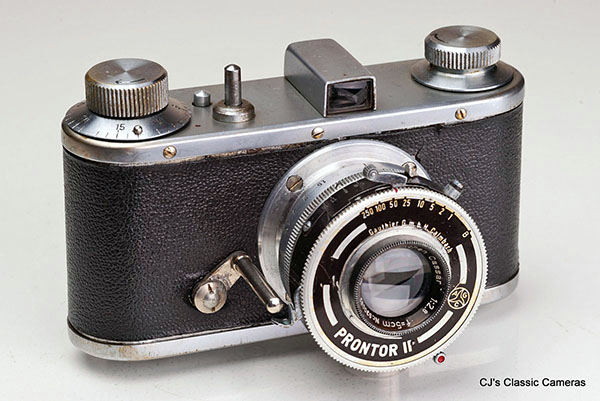
An original Ilca, here with Steinheil Cassar 50mm f/2.8 lens in Prontor-II shutter.

|
(left) Top and bottom views of the Ilca showing the helical focus mount and shutter release mechanism. Note the camera name was engraved on the bottom of the camera, which was rather unusual.
|
The Ilca never reached full-scale production, but the actual number that were made is unknown, a few hundred at most. The camera could be found with a variety of lenses, including a Friedrich Corygon (from Munchen, a long way from Hamburg!), a Steinheil Cassar, but also their own branded Illmar lens, reputedly made by ISCO, a subsidiary of
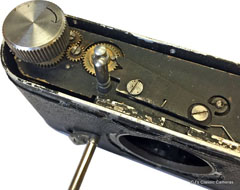
| |
Schneider. Walter Illing again got into a dispute with this name, this time with Leica, who found it too similar to their Elmar. Hence, it was renamed Ilitar on the later Iloca I.
(left) Wind and shutter release mechanism of the Ilca including double exposure prevention, all quite different from the later Iloca I design (see below).
|
Iloca I v.1
Clearly pleased with his Ilca design, Walter Illing had great plans for his company but lacked capital and therefore brougt in an investor, Wilhelm Witt. The Ilca was redesigned and simplified, probably to keep the cost down and make mass production easier, and was renamed Iloca. It also did away with an apparent weak spot, the body-mounted shutter release.
The first Iloca I had a Vario shutter with a black and white shutter face plate. Few were made with a Prontor II shutter. The lens was a Illing Ilitar f/3.5, which on later versions was marked with a V indicating a coated lens (even though the earlier versions also had coated lenses).
The camera had no double exposure prevention as the shutter was cocked and released on the shutter itself. To wind the camera after taking a picture one had to press down on the wind knob first, this would reset the wind lock.
Like with all bottom-loading cameras, loading the camera was a bit cumbersome and it was easy to tear the film perforations if done improperly. In fact, most of the Iloca I-IIa series cameras I have had my hands on had shredded bits of film clogging the inside! The trick is to cut a longer lead-in at the beginning of the film, as one would do for loading screw-mount Leicas. This makes sure the film is guided properly over the sprocket wheel inside the camera. See also here for the instruction manual of the Iloca Ia, which loads the same way.
(left) An Iloca I with Jlling Jlitar lens (note that J stands for a capital I). The lens serial# is 01419, note the focal length is indicated as 'F=4,5cm". The leather covering is non-original. (top right) A slightly earlier Iloca I with lens serial #00825, note that here the focal length is marked 'f=4,5 cm' (no capital F). (bottom right) Top view of an Iloca 1.

The Iloca I from the picture above whilst being serviced. A relatively simple camera without too many parts. However, to get to the inside one needs to remove the leather covering and the main body.

The same Iloca undergoing testing of the wind lock mechanism. Winding the film and engaging the film sprockets rotates a small cylinder with a pin that pushes sideways the little catch in the middle of the picture. The large peg then shoots into a cog wheel under the winding knob and stops it from rotating further. To reset the mechanism one needs to push down the winding knob, the bottom of which is conical. This pushes back the large peg till the catch catches it and one can wind the film again for the next exposure. This movement of the peg also pushes the frame counter one tick forward.
Iloca I v.2
The second version of the Iloca I had a metal shutter face with the name Iloca engraved. They generally had Prontor-S shutters. The redesigned frame counter had a circle engraved around the frame numbers. The serrated wind knob received two horizontal grooves and the rewind knob was restyled to match the wind knob. On later production models (from around lens serial# 10,000) the domed locking nut of the wind knob was replaced with a flat one. The same style knobs were also used on the later Iloca Ia.
A few very late examples of the Iloca I v.2 with lens serial# >25,000 had lenses marked Jloca (not Jlling) Jlitar and had no Iloca engraving on the front plate. Perhaps these were assembled from left-over parts from Iloca Ia production.
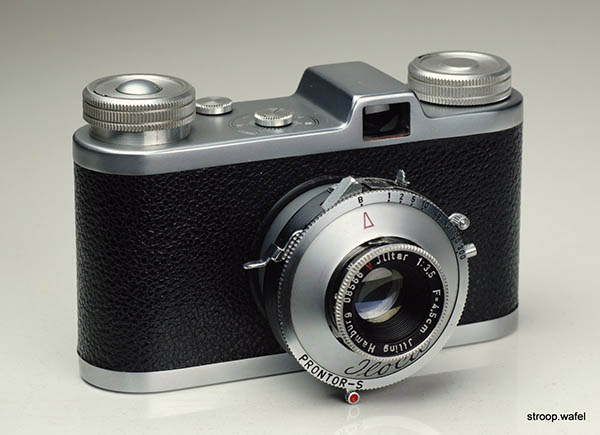
Second version of the Iloca I with Iloca engraved on a metal shutter face. This example has the early production, domed wind knob nuts, which were the same as on the Iloca I v.1.
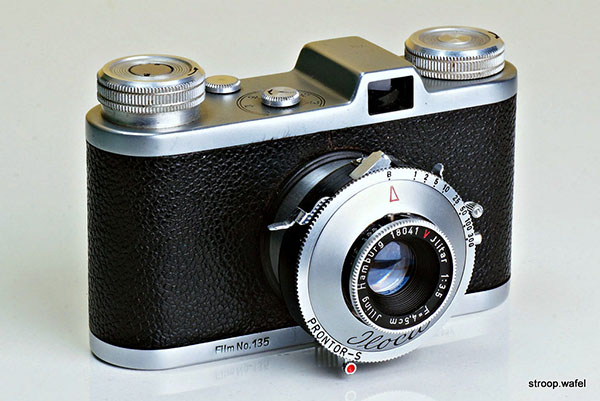
Later production variant of the Iloca I v.2, nearly identical to the example above but with later production wind knob nut.
Iloca Ia v.1
The Iloca Ia was developed from the Iloca I v.2, the main distinguishing feature was the body-mounted shutter release. It had double-exposure prevention and automatically reset the wind lock: one no longer needed to push down on the wind knob to be able to advance the film. Other changes were the frame counter, now visible through a window in the top plate, and the style of the R button. Also, a metal collar was mounted around the lens base.
The Iloca Ia production can be divided two main versions, the first was quite similar to the Iloca I v.2 with a black lens ring and a rewind button on the top housing, the second version had a silver-coloured lens ring, a depth of focus scale at the camera back and a rewind switch at the back of the top housing.
In addition, there was a plethora of combinations of shutters, shutter face markings and focus and shutter speed indicators. One variant of the Iloca Ia v.1 had a blank shutter plate and usually an open red triangle as a shutter speed indicator and a red dot as focus indicator, but versions without dots or with closed red triangles can also be found. A second variant had Iloca embossed on the shutter plate, a red triangle indicating the shutter speed and a silver-coloured frame counter. Initially lenses were marked Jlling Jlitar, later Jloca Jlitar. A few examples had very low serial# around 7,000, possibly left-over lenses from earlier production of the Iloca I.
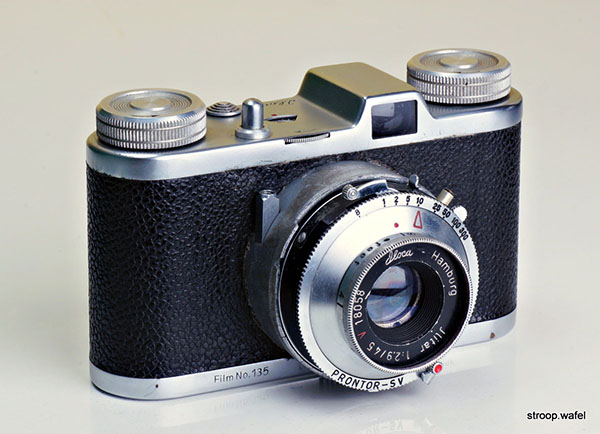
First type of Iloca Ia v.1 with blank metal shutter face and an open triangle to indicate the shutter speed.
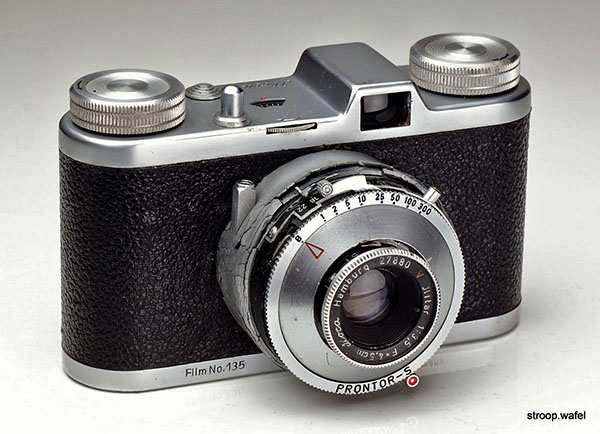
Another Iloca Ia v.1, very similar to the one above but instead of a dot marking the focus distance, this one had a small tab. It also has a slower f/3.5 lens and a Prontor-S shutter instead of a Prontor-SV. Even though its lens serial# was higher than that of the example above, the body serial # (115 345 vs 118 316) suggests this one was made earlier.

Yet another very similar looking Iloca Ia. This one has a dot instead of an open triangle as speed marker.
It is unclear which of the two variants of the Iloca Ia v.1 was first. Based on lens serial # the first variant was the earliest. However, the second variant still had lenses with a small screw on the ring functioning as a focus stop, just like the Iloca I had. In addition, some of them are still marked Jlling, again just like the Iloca I. Finally, the second variant had no body serial#, whereas the first variant does, which is typical of later Ilocas. Perhaps lens serial# are unreliable indicators of the order in which cameras were build.
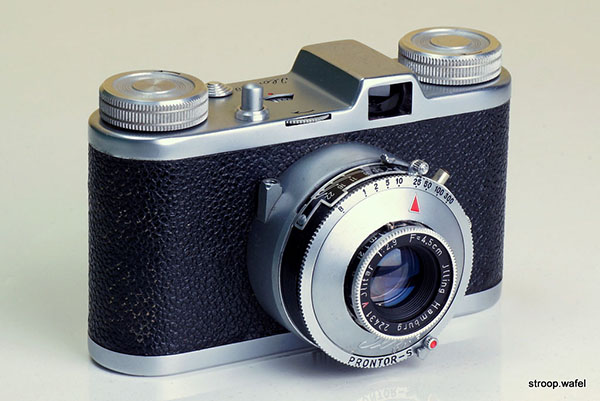
Second type Iloca Ia v.1 with Iloca embossed on the metal shutter face and a red triangle to indicate the shutter speed. The lens is similar to that of the Iloca I v.2. Note that it is marked Jlling, like the early Iloca Is. Just visible is the new style conical rewind button.
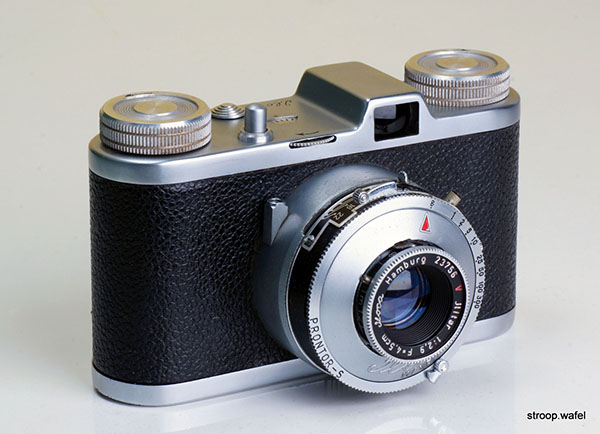
A nearly identical Iloca Ia v.1 as the one above, but on this example the lens is marked Jloca, not Jlling.
Iloca Ia v.2
The second version of the Iloca Ia had a silver-coloured lens, a depth of field table at the back of the camera and a rewind lever at the back of the top plate instead of a bottom on top. These changes occurred around lens serial# 29,000. Initially most had Vario shutters, later ones had Prontor-S or SV shutters. Some changes occurred to the marking on the shutter plate during production. Early v.2s (lens serial# around 30,000) had an open triangle indicating the shutter speed and a red dot indicating the focus distance. The main production (serial 33,000-44,000) had two red dots. Some really late ones (serial around 67,000) had two dots much further apart. They all had black frame counters.
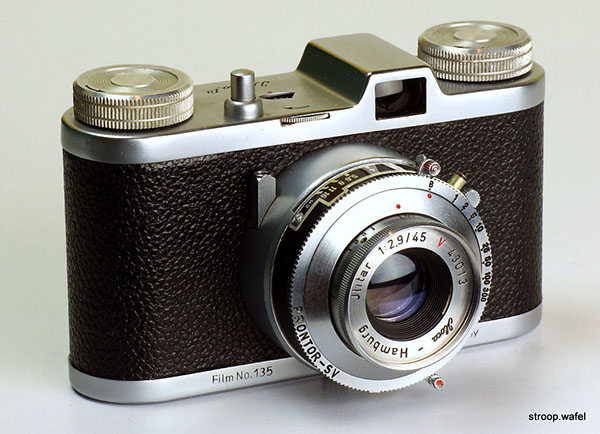
Main version of Iloca Ia with a silver-coloured lens and red dots indicating shutter speed and focus distance. On the top there's no longer the rewind button, which has been replaced by a small lever at the back of the camera. This camera also features a panel with depth of field table (see below).

Rear side of the camera above showing the new rewind lever and depth of field table.
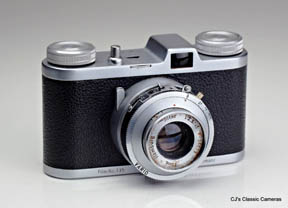 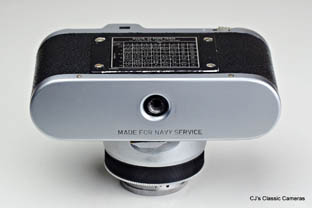
This example is marked 'Made for Navy Service' on the bottom. Other than having a Vario shutter it is otherwise identical to the example above. I am still puzzled that these cameras would have been sold to the Navy, but there's a good few around all in a similar serial# range, so presumably they are genuine. It would be interesting to hear from anyone who actually used those, or knows about someone who did!
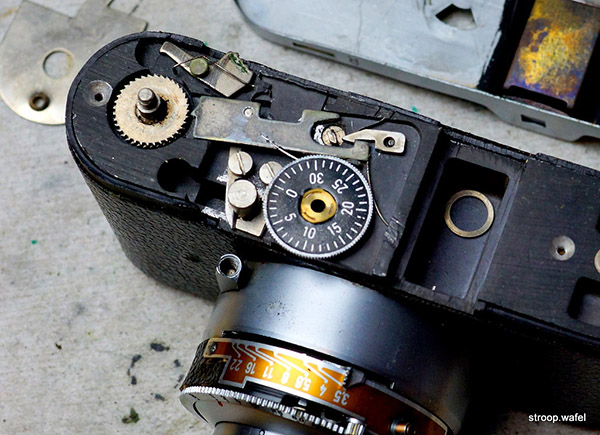
The wind mechanism of the Iloca Ia. Compared to the Iloca I it features a double exposure prevention. This is activated by the same peg that engages the wind lock whilst winding the film. Pushing down the shutter release releases the wind lock, as opposed to having to push down the wind knob on the Iloca I.

Late version of Iloca Ia with the red dot indicators much further apart as the shutter speed ring was rotated compared to earlier production.
Shutter faces of Iloca I and II series
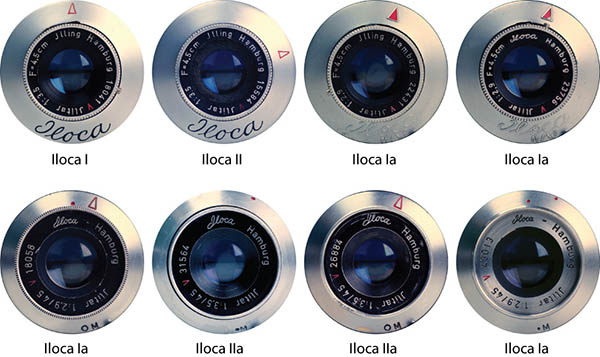
To illustrate of the wide range of shutter plate and lens ring markings the early Ilocas came with, here is a small summary. Iloca I v.2 and Iloca II appear to all have had the same shutter face. There are at least seven variants of the Iloca Ia, four of them shown here, and at least four of the Iloca IIa, two of them shown here, the other two being similar to the Iloca Ia on the top and bottom right, respectively. A bonanza for collectors!
Feca = Fake Iloca?
The title is meant a little tongue in cheek, but there is no denying that the Feca was essentially a plastic Iloca I. The cameras have nearly identical bodies, all functions were the same and even the arrangement of the viewfinder, frame counter and rewind button are identical. Only the lens base is different, as the Feca has a collar, rather like the Iloca Ia. So how did this happen?
There is precious little information about the company that made the Feca (Fertsch Camera), other than that it was set up by the brothers W. and P. Fertsch in Jena, home also to the Carl Zeiss factories. They appear to have made only two cameras, the Feca Flex, a rare and rather boxy little camera with an Exakta-style waist-level viewfinder that fetches astronomical prices on auction sites, and said Feca. There were several variants, with and without strap lugs (commonly named A and B, respectively) whereas a version with white wind knobs can also be found. Most had a tapered lens collar but straight versions can also be found.

A Feca A (without strap lugs).

What lies beneath the top plate... the Feca is similar to the Iloca Ia down to the inner parts.
Fecas are hard to service as all parts are made from bakelite and stick together harder than glue, but the material is brittle enough to break suddenly under stress. Fortunately this one did budge in the end without damage.
Typically the Feca came with a Ludwig Meritar 50mm f/3.5 lens in a Junior shutter, therefore the camera is sometimes called the Feca Junior. I have seen one with a Tessar in a Compur-Rapid shutter, but if this is original I do not know. The Tessar seems not impossible, considering Carl Zeiss was around the corner. However, it seems unlikely that a West-German Compur-Rapid was exported to East-Germany, as at that time East-German companies used their own (renamed) shutters due to licensing issues.
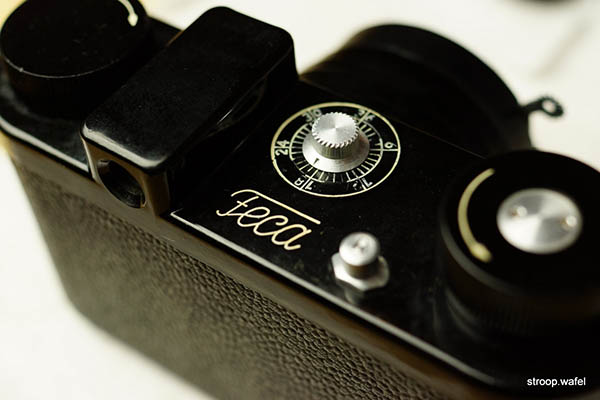
Top view of Feca showing Feca logo and frame counter.
I have tried to find out if Fertsch could have licensed the design from Iloca or what their connection with Hamburg could be, but no luck so far. In any case, the company cannot have been very successful as it made no further models. Whatever its origin, it is a rather cute little camera and the gold-coloured lettering on the black background makes a look a little more classy than the Iloca I itself.
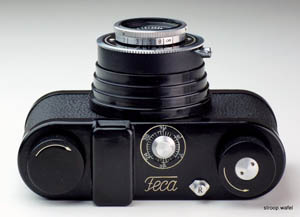

Top view of Feca A and Iloca I side by side for comparison.
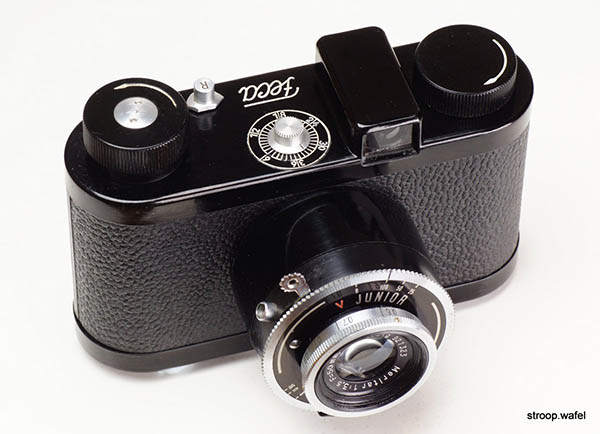
A version of the Feca with straight lens collar. Based on the lens serial # this one is older than the one above, but some have lens serial # overlapping those with tapered lens collars.
| 
